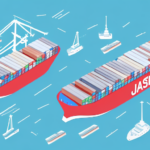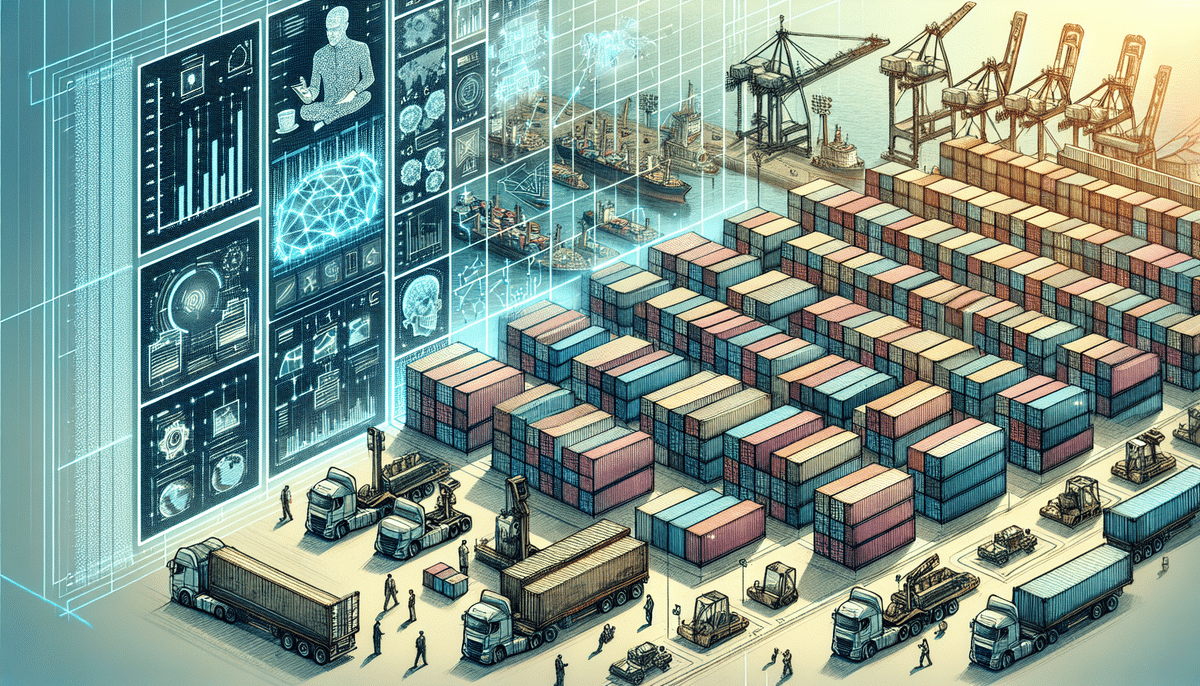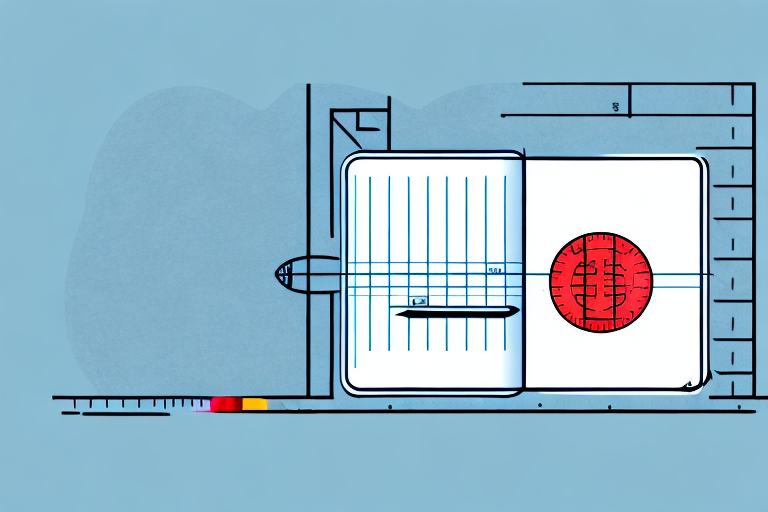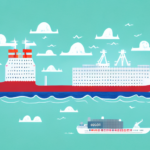Understanding the TEU (Twenty-Foot Equivalent Unit) and Its Impact on Global Trade
The TEU (Twenty-Foot Equivalent Unit) is a standard unit of measurement used in international shipping to quantify the volume of containerized cargo. The use of TEU has revolutionized the shipping industry by facilitating the efficient handling, transport, and storage of cargo. In this article, we will explore the history and evolution of TEU, its benefits, the role it plays in the growth of global trade, technology innovations, and future prospects.
The History and Evolution of TEU in International Shipping
The concept of containerization of cargo emerged in the 1950s as a result of the need to simplify the loading and unloading of cargo, speed up transportation, and reduce damages, theft, and losses. The initial containers were of varying sizes, which made it challenging to quantify cargo volumes. In 1968, the International Organization for Standardization (ISO) established the standard container size of 20 feet (6.1 metres) and introduced the concept of a TEU. The TEU was defined as the volume of a single 20-foot container, which allowed for accurate quantification of cargo volumes and tracking of shipping statistics.
The introduction of TEUs revolutionized the shipping industry by enabling the standardization of container sizes and the development of container ships. Container ships are designed to carry a specific number of TEUs, which has led to the development of larger and more efficient vessels. The use of TEUs has also facilitated the growth of global trade by making it easier and more cost-effective to transport goods across long distances.
Today, TEUs are the standard unit of measurement for containerized cargo and are used to calculate shipping rates, track cargo volumes, and plan vessel capacity. The size of container ships has continued to increase, with some of the largest vessels now capable of carrying over 20,000 TEUs. The use of TEUs has also led to the development of specialized container handling equipment, such as cranes and forklifts, which are designed to efficiently load and unload containers from ships and trucks.
How TEU Became the Standard Unit of Measurement for Containerized Cargo
The adoption of TEU as a standard unit of measurement was facilitated by several factors, including the standardization of container sizes, the development of container tracking and management systems, and the widespread use of container ships. The use of TEU allowed for the simplification of cargo volume calculations, accurate billing and pricing, and efficient use of containerized cargo space.
TEU, or Twenty-foot Equivalent Unit, was first introduced in the 1960s by the shipping industry as a way to standardize the measurement of containerized cargo. Prior to the adoption of TEU, cargo was measured in a variety of ways, including weight, volume, and number of items. This lack of standardization made it difficult for shippers to accurately calculate the space needed for their cargo and for carriers to efficiently load and transport the cargo.
The Benefits of Using TEU to Measure Shipping Volumes
The use of TEU has brought numerous benefits to the shipping industry, including improved cargo handling, higher efficiency, lower transportation costs, and reduced damage and loss rates. By adopting TEU as the standard unit of measurement, shipping companies can accurately calculate vessel and port specifications, container utilization, and cargo movements. Additionally, it enables better vessel utilization analysis, increased automation in cargo handling, and effective planning for port infrastructure.
Another benefit of using TEU is that it allows for easier comparison of shipping volumes across different ports and vessels. This standardization of measurement makes it simpler for companies to evaluate the efficiency of their operations and identify areas for improvement. It also facilitates the sharing of data and information between different stakeholders in the shipping industry, such as shippers, carriers, and terminal operators.
Furthermore, the use of TEU has contributed to the development of larger and more efficient container ships. As shipping companies strive to increase their capacity and reduce their costs, they have invested in vessels that can carry more TEUs per voyage. This has led to economies of scale and lower transportation costs for both the companies and their customers. However, it has also raised concerns about the environmental impact of these larger ships and the potential risks associated with their operation.
The Role of TEU in the Growth and Development of Global Trade
The adoption of TEU has played a significant role in the growth and development of global trade. Its use has made containerized shipping more efficient and cost-effective, leading to lower transportation costs and higher trade volumes. The standardization of container sizes and TEU as a unit of measurement has also made it easier for companies to plan and manage their supply chain operations, leading to increased efficiencies and higher profits.
Furthermore, the use of TEU has also contributed to the reduction of carbon emissions in the shipping industry. By optimizing the use of space in containers, fewer ships are needed to transport the same amount of goods, resulting in lower fuel consumption and emissions. This has led to a more sustainable and environmentally friendly approach to global trade.
How TEU Helps Shipping Companies Optimize their Operations and Maximize Profits
TEU has helped shipping companies optimize their operations and maximize profits in various ways. By accurately measuring cargo volumes and efficiently utilizing container capacity, shipping companies can reduce transportation costs, optimize vessel schedules and speeds, and manage cargo inventory more effectively. Additionally, the use of TEU has facilitated the development of fully automated shipping operations, leading to lower labor costs and higher efficiencies.
Another way TEU helps shipping companies is by providing real-time tracking and monitoring of cargo. This allows companies to have better visibility of their cargo and make informed decisions about routing and delivery times. TEU also provides data analytics tools that enable companies to analyze their operations and identify areas for improvement.
Furthermore, TEU has a positive impact on the environment by reducing carbon emissions. By optimizing vessel schedules and speeds, shipping companies can reduce fuel consumption and emissions. Additionally, TEU promotes the use of eco-friendly containers and packaging materials, which further reduces the environmental impact of shipping operations.
The Impact of TEU on Port Infrastructure and Logistics Planning
The adoption of TEU has had a significant impact on port infrastructure and logistics planning. TEU allows for better planning of port layouts, container stack capacity, and cargo handling equipment procurement. It also enables the optimization of cargo flows, leading to faster turnaround times and reduced waiting times for vessels. By using TEU, port operators can also predict and prepare for changes in demand and manage their resources more efficiently.
Furthermore, the standardization of container sizes through TEU has led to increased efficiency in intermodal transportation. Containers can be easily transferred between ships, trucks, and trains, without the need for time-consuming and costly repackaging. This has resulted in lower transportation costs and improved supply chain reliability. Additionally, the use of TEU has facilitated the growth of global trade, as it has made it easier and more cost-effective to transport goods across long distances and between different modes of transportation.
Innovations in Shipping Technology and Their Influence on TEU Standards
The shipping industry has witnessed significant technological advancements in recent times, with innovations such as blockchain, the internet of things (IoT), and artificial intelligence (AI) revolutionizing shipping operations. These advancements have had a significant influence on TEU standards and are driving the development of new standards. For instance, the use of IoT sensors in containers is making it possible to track cargo movements accurately, reducing the risk of theft and loss. Blockchain technology is also facilitating secure and transparent shipping transactions, leading to faster and more efficient shipping processes.
Another significant innovation in shipping technology is the use of autonomous ships. These ships are equipped with advanced sensors and navigation systems that allow them to operate without human intervention. This technology has the potential to reduce the cost of shipping and improve safety by eliminating the risk of human error. However, there are still concerns about the safety and security of autonomous ships, and regulatory frameworks are still being developed to address these issues.
In addition to these technological advancements, there is also a growing focus on sustainability in the shipping industry. Many companies are exploring alternative fuels and propulsion systems to reduce their carbon footprint. For example, some companies are experimenting with hydrogen fuel cells and wind-assisted propulsion systems. These innovations have the potential to significantly reduce greenhouse gas emissions from the shipping industry and contribute to global efforts to combat climate change.
Challenges Facing the Adoption of TEU in Emerging Economies
Despite the numerous benefits of TEU, its adoption in emerging economies faces various challenges, including inadequate port infrastructure, limited access to containerized cargo, government regulations, and limited financial resources. Additionally, some countries lack the necessary expertise and knowledge to operate container terminals efficiently. These challenges highlight the need for collaboration between shipping operators, governments, and other stakeholders to address infrastructure and logistical deficits and increase trade activity in these regions.
Another challenge facing the adoption of TEU in emerging economies is the lack of standardization in container sizes and types. This can lead to inefficiencies in cargo handling and transportation, as well as increased costs for shippers. To address this issue, industry stakeholders are working to establish global standards for container sizes and types, which would facilitate the adoption of TEU in emerging economies.
Furthermore, the adoption of TEU in emerging economies can also have environmental implications. The increased use of containerized cargo can lead to higher carbon emissions from transportation and handling. To mitigate these effects, stakeholders are exploring alternative energy sources and more efficient transportation methods, such as rail and inland waterways, to reduce the carbon footprint of TEU adoption in emerging economies.
The Future of TEU in the Changing Landscape of Global Trade
The future of TEU in the shipping industry looks promising, with several advancements likely to drive the development of new standards and technologies. The increasing globalization of trade, growing demand for sustainable and eco-friendly shipping, and technological advancements will shape the future of TEU. Furthermore, collaborations between shipping companies, governments, and other stakeholders will be critical in driving its adoption in emerging economies and facilitating growth in global trade.
In conclusion, TEU has revolutionized the shipping industry, enabling the efficient handling and transport of cargo and facilitating the growth of global trade. The standardization of container sizes and the use of TEU as a unit of measurement has brought numerous benefits to shipping companies, including higher efficiency, lower costs, and increased profitability. TEU will continue to play a vital role in the future of global trade, with new developments in technology and increasing collaboration between stakeholders driving its adoption.








